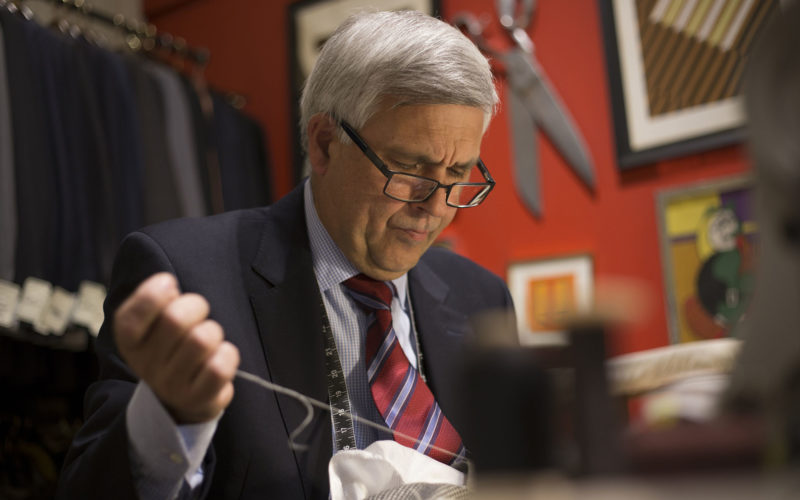Q. I was clothes shopping with my brother and realized why some of his clothes don’t seem to fit him right. He was finding good clothes on sale but not in his exact size; pants anywhere from 34 waist to 36 and lengths from 30-32. Likewise, he was buying shirts in sizes from medium to extra-large. Can you please tell him to be sized and only buy his correct size?
A. You and your brother are both right to an extent, but you definitely more so. Measurements are often not to the exact inch and clothing manufacturers often vary in their sizing, so a garment listed at one size might be off by one digit higher or lower than another. Also, a looser or tighter waist will drop or raise the rest of the pants’ length. But knowing one’s measurements and actually trying on clothes is the safe way to assure you get clothes that fit you perfectly . . . buying only those that fit right or can be tailored to fit right is indeed the way to look one’s best.
If your brother is in the middle of the sizes you mention – a 35 waist, 31 length when measured – it is certainly possible that a 34/32 or 36/30 suit from one company would be an appropriate size for him. Similarly, shirts that do not come in exact measured sizes (those that come in S, M, L, and XL) can vary greatly.
A fit man, who is a large, might have been an extra-large in shirt sizes in the past and now fits into a large or even a medium. Many manufacturers have increased their sizes. The reason for this is both the average man’s being a bit larger than in the past and that most everyone likes to think of himself, even if unrealistically, as being a smaller size than he actually is.
Both reasons for variation aside, he should never assume either without actually trying them on. There is an old saying that men and women are totally different: “Women are from Venus, men are from Mars”; nowhere is this more true than men’s resistance to trying clothes on to see if they fit well and look good on. When a man goes shopping for clothes, it really is essential to try the item on. If possible, he should do so in the presence of a knowledgeable tailor who knows how a jacket should fit across the shoulders and how the trousers should fit in the seat, the waist, and the length.
When there is no tailor available, a man needs to check himself out objectively in a full-length mirror. If the shoulders are wrong, he should not buy the item, the alteration is too major. But if the fit in the waist, the seat, or the length is wrong, it can, and should, be altered. Oddly enough, an expensive suit or jacket that fits poorly often does not look as good as a bargain item (even from a thrift store) that has been tailored to fit perfectly.
These days a correct fit is one that slightly hugs the body, that sits comfortably at the waist and the seat, that is the right length so the sleeves and the hems of the pants are not too long. All these should be altered if they are not correct. The baggy look is out of style. No matter what size a man claims he has worn for years, his size today is what matters. And this is also true for shirts. As years pass, most men go up a size and now need the next size in their shirts’ neck and sleeve measurements.
Another common mistake that men make is wearing trousers that are too long and that puddle around the ankles. The modern look is just long enough to have a slight break above the shoe. Also, don’t choose dress pants that are too tapered, making them look too casual. Be consistent. Well-dressed men don’t mix casual styles and dressy styles in the same outfit.
In terms of shirts, many men make the “any close size” choice for non-measured shirts. As you point out, this is often a mistake. A polo or even a T-shirt is embarrassing when too tight, and sloppy when too loose. With actual button-front dress shirts, the wrong choice is as inappropriate as a mis-sized suit. Still, a shirt should never provide an exact outline of a man’s shape, especially when he is too large at the waist.
So, to provide an official referee to your argument with your brother: unless he had experience with each manufacturer and had previous knowledge of which items ran small or large for him, you are right, he should have tried them on and relied on his, your, or a professional’s feedback. I always recommend that a man begin his shopping experience in a reliable, upscale shop where the prices might be more than he is used to. The salesperson and the tailor will know exactly how to measure him correctly. They know that the jacket needs to fit him right in the shoulders, and the pants need to be his correct size in the seat (a too-big or too-small waist size is easy to alter). Then, whether or not he actually buys an item there, he will at least know what is his correct size and will have gotten some smart feedback about what looks good on him.
Please send your men’s dress and grooming questions and comments to MALE CALL: Lois.Fenton@prodigy.net









